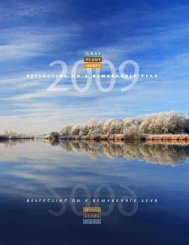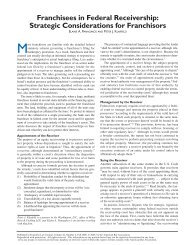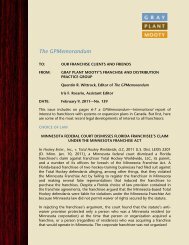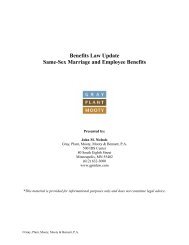Los Angeles Lawyer October 2008 - Gray Plant Mooty
Los Angeles Lawyer October 2008 - Gray Plant Mooty
Los Angeles Lawyer October 2008 - Gray Plant Mooty
You also want an ePaper? Increase the reach of your titles
YUMPU automatically turns print PDFs into web optimized ePapers that Google loves.
ments or questions, a court can engage in<br />
“comparative juror analysis” to identify differences<br />
between the questions asked of<br />
minority and nonminority jurors. A significant<br />
difference may support the inference that the<br />
variance reflects an attempt to generate a<br />
purportedly nonracial basis for dismissing<br />
jurors based on group bias. 41<br />
The Ninth Circuit has held that comparative<br />
juror analysis is appropriately used in<br />
assessing a prima facie case; that it is “an<br />
important tool that courts should use on<br />
appeal” even if it was not used by the trial<br />
court; and that it requires examination of<br />
the entire voir dire, prior to and after the<br />
exercise of the challenged peremptory, to permit<br />
a meaningful comparison between what<br />
was asked of jurors belonging to varying<br />
groups. 42 Both in making and defending<br />
Batson/Wheeler challenges, therefore, parties<br />
will need to make sure the record reflects<br />
the group membership not only of struck<br />
jurors but also of any jurors to whom the<br />
party wants to point for comparison of voir<br />
dire questions and statements, whether those<br />
questions and statements occurred before or<br />
after the challenged peremptory.<br />
Demonstrating a prima facie case does<br />
not require a showing that a party struck<br />
more than one member of a particular<br />
group. 43 Nevertheless, a recent Third Circuit<br />
decision suggests the crucial importance of<br />
developing the record regarding two different<br />
measures relating to the pattern of strikes: the<br />
“strike rate,” which is “computed by comparing<br />
the number of peremptory strikes the<br />
prosecutor used to remove black potential<br />
jurors with the prosecutor’s total number of<br />
peremptory strikes exercised,” and the “exclusion<br />
rate,” which is “calculated by comparing<br />
the percentage of exercised challenges<br />
used against black potential jurors with the<br />
percentage of black potential jurors known to<br />
be in the venire.” 44<br />
The case, Abu-Jamal v. Horn, involved the<br />
highly publicized death penalty conviction<br />
of a black man for the murder of a white<br />
Philadelphia policeman. The record revealed<br />
the strike rate, which was 66.67 percent,<br />
resulting from the prosecution exercising 10<br />
out of 15 peremptories against black jurors. 45<br />
But the record contained no “factual finding<br />
at any level of adjudication, nor evidence<br />
from which to determine the racial composition<br />
or total number of the entire venire—<br />
facts that would permit the computation of<br />
the exclusion rate and would provide important<br />
contextual markers to evaluate the strike<br />
rate.” 46 The court found this failing fatal to<br />
the defendant’s effort to challenge the state<br />
court’s finding of no prima facie case under<br />
Batson: “Without this evidence, we are unable<br />
to determine whether there is a disparity<br />
between the percentage of peremptory strikes<br />
exercised to remove black venirepersons and<br />
the percentage of black jurors in the venire.” 47<br />
This holding emphasizes the importance of<br />
developing a record regarding not only the<br />
group identity of the jurors against whom<br />
peremptories were exercised but also the<br />
numbers of group members in the venire as<br />
a whole. This includes, under the jury box<br />
method, not only those jurors against whom<br />
peremptories could have been but were not<br />
exercised but also those members of the venire<br />
who did not even make it to the jury box.<br />
Once a prima facie case is established,<br />
the second Batson/Wheeler step requires the<br />
party seeking to exercise the peremptory to<br />
provide a race-neutral reason for exclusion.<br />
At this second stage, so long as the proffered<br />
rationale is facially race-neutral, a court can<br />
evaluate neither its persuasiveness nor its<br />
plausibility. 48 But a court is not without the<br />
ability to assess the facial credibility of the<br />
proffered reason, and, in this regard, development<br />
of the record is crucial. Many proffered<br />
race-neutral reasons depend on physical<br />
characteristics or physical actions that<br />
will not be apparent from the transcript of<br />
voir dire. Take for example the rationales<br />
proffered for the striking of the two jurors at<br />
issue in Purkett v. Elem—namely, one juror’s<br />
long, curly hair, and both jurors’ facial hair. 49<br />
Whether challenging or supporting these<br />
rationales, a court finding whether or not<br />
the jurors at issue actually displayed these features<br />
would be critical to evaluating whether<br />
a credible, facially race-neutral rationale had<br />
been proffered.<br />
Similarly, one of the facially race-neutral<br />
rationales proffered for exercise of a peremptory<br />
in the Supreme Court’s recent decision<br />
in Snyder v. Louisiana was the statement that<br />
a juror “looked very nervous to me throughout<br />
the questioning.” The record did not<br />
contain any finding by the court regarding the<br />
juror’s demeanor, so the Court refused to<br />
“presume that the trial judge credited the<br />
prosecutor’s assertion that [the juror] was<br />
nervous” and declined to defer to the trial<br />
judge’s denial of the Batson challenge. 50<br />
The third step of the Batson/Wheeler<br />
analysis is the determination whether the<br />
party acted with actual discriminatory intent.<br />
Courts occasionally skip directly to this third<br />
step without making a finding whether a<br />
prima facie case has been established, either<br />
granting or denying a Batson/Wheeler challenge<br />
on a determination that a proffered<br />
race-neutral reason either does or does not<br />
represent the actual reason the peremptory is<br />
being exercised. The law is clear that when<br />
this happens, “the preliminary issue of<br />
whether the defendant had made a prima<br />
facie showing becomes moot.” 51 Nevertheless,<br />
We will speak to you<br />
in a way that<br />
clearly expresses<br />
what we mean.<br />
Even the most complex economic questions in litigation can be answered clearly -- if you<br />
ask the right economist. At Econ One, we know economics is far from plugging numbers<br />
into formulas and leaving clients with statistics to decipher. On the contrary,<br />
economics is insight and understanding created by thorough research, thoughtful<br />
analysis and clear, effective presentation. We go beyond the obvious to give<br />
our clients the clearly communicated answers they're looking for. econone.com<br />
Antitrust • Intellectual Property • Damages Analysis • Employment Issues<br />
<strong>Los</strong> <strong>Angeles</strong> <strong>Lawyer</strong> <strong>October</strong> <strong>2008</strong> 29







